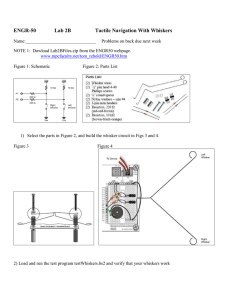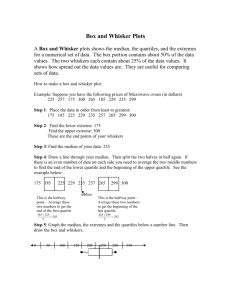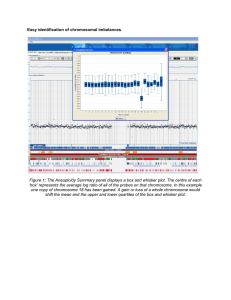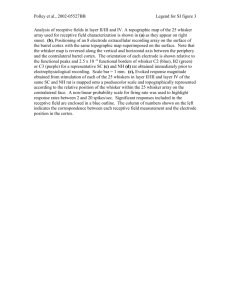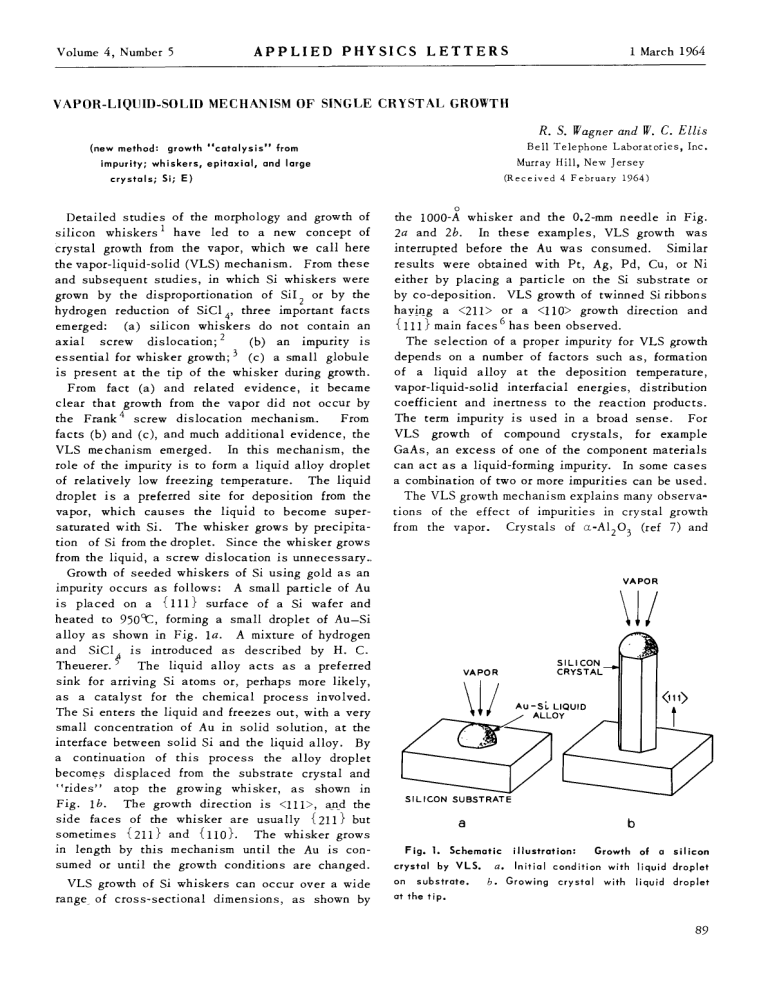
Volume 4, Number 5
APPLIED PHYSICS LETTERS
1 March 1964
VAPOR-LIQUID-SOLID MECHANISM OF SINGLE CRYSTAL GROWTH
R. S. Wagner and W. C. Ellis
(new method:
Bell Telephone Laboratories, Inc.
growth "catalysis" from
Murray Hill, New Jersey
impurity; whiskers, epitaxial, and large
(Received 4 February 1964)
crystals; Si; E)
Detailed studies of the morphology and growth of
silicon whiskers 1 have led to a new concept of
crystal growth from the vapor, which we call here
the vapor-liquid-solid (VLS) mechanism. From these
and subsequent studies, in which Si whiskers were
grown by the disproportionation of SiI or by the
2
hydrogen reduction of SiCI 4 , three important facts
emerged: (a) silicon whiskers do not contain an
axial screw dislocation; 2
(b) an impurity is
essential for whisker growth; 3 (c) a small globule
is present at the tip of the whisker during growth.
From fact (a) and related evidence, it became
clear that growth from the vapor did not occur by
the Frank 4 screw dislocation mechanism..
From
facts (b) and (c), and much additional evidence, the
VLS mechanism emerged. In this mechanism, the
role of the impurity is to form a liquid alloy droplet
of relatively low freezing temperature. The liquid
droplet is a preferred site for deposition from the
vapor, which causes the liquid to become supersaturated with Si. The whisker grows by precipitation of Si from the droplet. Since the whisker grows
from the liquid, a screw dislocation is unnecessary ..
Growth of seeded whiskers of Si using gold as an
impurity occurs as follows: A small particle of Au
is placed on a {Ill} surface of a Si wafer and
heated to 950OC, forming a small droplet of Au-Si
alloy as shown in Fig. lao A mixture of hydrogen
and SiCl is introduced as described by H. C.
Theuerer. 1 The liquid alloy acts as a preferred
sink for arriving Si atoms or, perhaps more likely,
as a catalyst for the chemical process involved.
The Si enters the liquid and freezes out, with a very
small concentration of Au in solid solution, at the
interface between solid Si and the liquid alloy. By
a continuation of this process the alloy droplet
become" displaced from the substrate crystal and
"rides" atop the growing whisker, as shown in
Fig. lb. The growth direction is <111>, a_n_d the
side faces of the whisker are usually {21d but
sometimes {211} and {llO}. The whisker grows
in length by this mechanism until the Au is consumed or until the growth conditions are changed.
VLS growth of Si whiskers can occur over a wide
range of cross-sectional dimensions, as shown by
o
the 1000-A whisker and the O.2-mm needle in Fig.
2a and 2b. In these examples, VLS growth was
interrupted before the Au was consumed. Similar
results were obtained with Pt, Ag, Pd, Cu, or Ni
either by placing a particle on the Si substrate or
by co-deposition. VLS growth of twinned Si ribbons
haY!l!g a <211> or a <llO> growth direction and
{Ill} main faces 6 has been observed.
The selection of a proper impurity for VLS growth
depends on a number of factors such as, formation
of a liquid alloy at the deposition temperature,
vapor-liquid-solid interfacial energies, distribution
coefficient and inertness to the reaction products.
The term impurity is used in a broad sense. For
VLS growth of compound crystals, for example
GaAs, an excess of one of the component materials
can act as a liquid-forming impurity. In some cases
a combination of two or more impurities can be used.
The VLS growth mechanism explains many observations of the effect of impurities in crystal growth
from the vapor. Crystals of a-A1 2 0 (ref 7) and
3
VAPOR
\11
SILICON
CRYSTAL
VAPOR
SILICON SUBSTRATE
a
b
Fig. 1. Schematic
crystal by VLS.
on
substrote.
a.
illustration:
Growth of
a
silicon
Initial condition with liquid droplet
b. Growing
crystal
with
liquid droplet
at the tip.
89
Volume 4, Number 5
APPLIED PHYSICS LETTERS
1 March 1964
SiC (ref 8), which have been shown to have rounded
terminations, may have grown by the VLS mechanism.
In the growth of BeO whiskers, which also show
rounded terminations, Edwards and Happel 9 suggested that a droplet of molten Be was present
at the tip of the growing whisker. However, they
also postulated a solid shell of BeO enclosing the
liquid Be, diffusion of oxygen through this shell
and the need for a crystalline defect, presumably a
screw dislocation.
None of these features is a
requirement of the VLS mechanism.
The proposed mechanism has widespread application to the growth of both filamentary and macroscopic
crystals and of epitaxial layers. Controlled growth
can be obtained through appropriate use of impurities
in patterns or films on substrate surfaces and on
single-crystal seeds of many substances.
P-N
junctions and heterojunctions can be made. Dislocation-free crystals can be grown.
W. G. Pfann contributed importantly to this work
in numerous stimulating discussions. We are also
grateful to H. C. Theuerer for valuable guidance in
setting up the conditions for the SiC1 4 reduction
and to R. D. Heidenreich and K. A. Jackson for
he lpful suggestions In the electron microscope
studies.
lR. S. Wagner, W. C. Eliis, K. A. Jackson, and S. M.
Arnold (for publication in J. Appl. Phys.).
2R • S. Wagner and W. C. Ellis, J. Metals 15, 76 (1963).
3E . S. Greiner, J. A. Gutowski, and W. C. Ellis,
Appl. Phys. 32,2489 (1961).
J.
0.3JL
0.5 MM
a
b
4F . C. Frank, Discussions Faraday Soc. 5, 48 (1949).
5 H. C. Theuerer, J. Electrochem. Soc. 108, 649 (1961).
6R • S. Wagner and R. G. Treuting, J. Appl. Phys. 32,
2490 (1961).
7W. W. Webb and W. D. Forgeng,
1449 (1957).
J. Appl. Phys. 28,
8K • M. Merz in Silicon Carbide-A High Temperature
Semiconductor (Pergamon Press, Inc., New York, 1960),
p 73.
9 p . L. Edwards and R. J. Happel, Jr., J. Appl. Phys.
33, 943 (1962).
90
Fig. 2.
Silicon crystals showing solidified gold-silicon
alloy oat tip.
1000-A
on
a
a.
whisker.
Tronsmission electron micrograph of
b.
{1l1} substrate.
Photograph
of
a
crystal
a
seeded
This is a twelve-sided needle
with alternating {211} and {11 O} faces.

